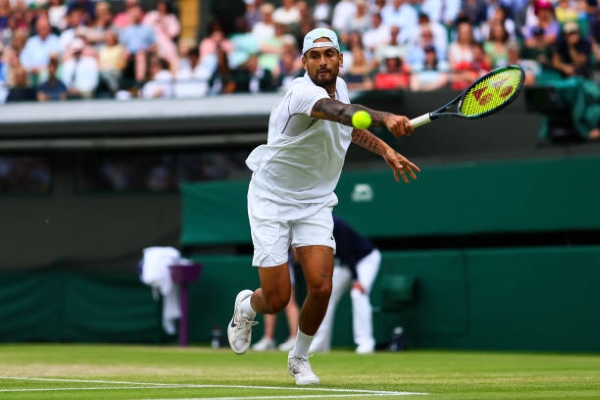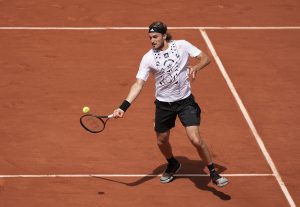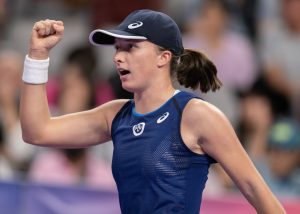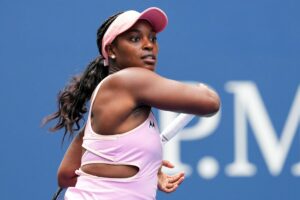After Rafael Nadal’s withdrawal from Wimbledon because of injury, Nick Kyrgios has received a bye or walkover to the final, making him the first Australian man to reach the Wimbledon singles final for nearly 20 years, or since Mark Philippoussis lost to Roger Federer in the 2003 final. Such a gap between Australian men’s finalists would have been unthinkable in the post-WW2 period and indeed most of the second half of the 20th century, when Australia was a tennis superpower and it was more likely that there would be two Australian men in the Wimbledon men’s singles final than none.
In many ways, Kyrgios is the antithesis of the Australian men who went before him at Wimbledon. His on-court behaviour, which consists of constant berating of officials, opponents and even himself, stands in complete contrast with the good humour, charm and sheer mate-ship demonstrated by most previous Australian male tennis players.
However, what Kyrgios does have in common with the greatest Australian men’s Wimbledon champions (and even runners-up) is his game. Although he is not a serve-volleyer, he does possess a gigantic serve that is arguably the best in the men’s game and also has superb touch and feel around the net. Consequently, as he has said himself, his game is made for grass and though he will be a big underdog against six-time champion Novak Djokovic in the final, he will be in with a chance of winning, especially as he will have had far more rest than his opponent.
Here, then, are the five Greatest Australian Men’s Wimbledon Champions. And if Kyrgios can emulate his compatriots from Down Under in winning The Big One Up Above, he might just merit inclusion in this most exclusive of clubs.
Five Greatest Australian Men’s Wimbledon Champions
- Pat Cash (One-Time Wimbledon Winner in 1987)
The ancestors of Norman Brookes and Gerald Patterson are entitled to disagree with the inclusion of Pat Cash on this list, as both men won two Wimbledon titles each as opposed to Cash’s singular triumph. However, those double triumphs came either just before World War One (in the case of Brookes) or just afterwards (in the case of Patterson). By contrast, Cash’s only Wimbledon win – indeed, his only Major triumph – came in what could be called the first golden age of men’s tennis, at least of the Open Era, when he defeated the then dominant world #1 Ivan Lendl in the 1987 final before starting a new tradition of climbing up to his player’s box to celebrate with his team.
It is the calibre of the men who Cash beat from the quarterfinals onwards in 1987 that enables him to edge ahead not only of Brookes and Patterson but other one-time Australian Wimbledon men’s champions such as Lleyton Hewitt. In the last eight in ’87, Cash defeated Mats Wilander, who was never comfortable on grass (Wimbledon was the only Major that he never won), but was still a great player and competitor; in the semifinal, he defeated two-time Wimbledon Champion Jimmy Connors; and in the final he subjected Lendl to his second consecutive Wimbledon final defeat (the great Czech had lost the 1986 final to Boris Becker). And what is most remarkable of all is that Cash won those three successive matches against three other great champions without losing a single set.
- Lew Hoad (Two-Time Wimbledon Winner in 1956 and 1957)
Lew Hoad enjoyed a relatively brief but none the less brilliant career in the Majors before turning professional in 1957 and suffering the same fate of so many great players from the amateur era (including the No.1 on this list) by being banned from the Majors for the next decade. Consequently, as with so many of those pre-Open Era greats, it is impossible to know how many Majors he might have won if he had not decided to make a living from his God-given and Hoad-honed talents.
In 1956 and 1957, just before he turned professional, Hoad was undeniably the best male tennis player in the world, as he won four Majors in those two seasons, including three in 1956. That year, he suffered the same fate as Novak Djokovic in 2021, when he won the Australian Open, the French Open and Wimbledon but lost in the final of the US Open, to his compatriot Ken Rosewall. The following year, Hoad did not fare nearly as well, but he did retain Wimbledon and gained at least a modicum of revenge on Rosewall by beating him in the final.
- Roy Emerson (Two-Time Wimbledon Champion in 1964 and 1965)
Roy Emerson is often the forgotten man of men’s tennis – not only Australian men’s tennis but men’s tennis globally. Yet he won won more Majors than any other Australian man, or indeed any man from anywhere before him, with 12 in total, six of them coming at his home Major, the Australian Open. That record stood until Pete Sampras surpassed it at Wimbledon in 2001 with his 13th Major victory (Sampras would go on to win one more US Open after that), before it was completely eclipsed by The Gigantic Three of this era, the greatest age of men’s tennis: Rafael Nadal, Novak Djokovic and Roger Federer.
In large part, Emerson does not receive the acclaim he deserves because most of his Majors were won after so many of his compatriots, including Lew Hoad, had turned professional and thus were banned from playing at the greatest events in tennis. Nevertheless, Emerson won two Wimbledon titles in succession, beating yet another Australian, Fred Stolle, in the final in both 1964 and 1965. He would never win Wimbledon again, but did win two more Australian Opens and one more French Open before he retired.
- John Newcombe (Three-Time Wimbledon Winner in 1967, 1970 and 1971)
Newcombe was the last of the great post-war Australian Wimbledon Champions, when the country’s strength in depth, particularly on the male side, was such that it could contest 14 successive Davis Cup Finals against the USA between 1946 and 1959, winning half of them. Newcombe emerged after that grandest of eras in Australian men’s tennis. Nevertheless, he was still part of several Davis Cup-winning teams and also won a hat-trick of Wimbledon titles to go alongside his two Australian Open titles and two US Open triumphs.
Like Pete Sampras some two decades later, only the French Open eluded Newcombe, but in a way that was a testament to his superb serve-volley game, which, like that of Sampras, did not translate well to clay. With his trademark droopy moustache and seemingly permanent grin, Newcombe was one of the most famous male tennis players in the late 1960s and early 1970s, when the sport transitioned from amateurism to professionalism. However, it was his quintessentially Aussie serve-volley style that really defined him, so much so that at least one other Australian Wimbledon winner, Pat Cash, openly admits to having modelled his own serve on that of the great John Newcombe.
1.Rod Laver (Four-Time Wimbledon Winner in 1961, 1962, 1968 and 1969)
The greatest Australian Men’s Wimbledon Champion is the man who many people, including John McEnroe, still regard as the greatest male tennis player ever, Rod “The Rocket” Laver. Laver twice won Wimbledon back to back, first at the start of the 1960s and then again at the end of the decade. And if it had not been for his being banished from the Majors for daring to turn professional, so that he could make a living from the sport that he excelled at, it is not inconceivable that he might have won 10 Wimbledon titles in a row, such was his dominance in London SW19, even over his fellow Aussies.
Of course, Laver’s domination of men’s tennis was not limited to Wimbledon, as he remains the only man to have won the Calendar Grand Slam – i.e. the actual Grand Slam of winning all four Majors in a single year – twice, first as an amateur at the start of the 1960s and then again at the end of the decade when he was finally allowed to compete again at The Majors as a professional. The fact that none of Nadal, Djokovic or Federer have won even one Calendar Grand Slam is yet another testament to his greatness.
And yet, for all the greatness of Laver at the start and the end of 1960s, it is arguable that the tennis world (or at least the fans at the four Majors) never saw him at his absolute peak, in his mid-20s, which coincided with his ban for having turned professional. If that is the case, then he is in the most stellar company with two other icons of the Sixties (and beyond). John Lennon always maintained that The Beatles were at their absolute best in Hamburg in the early 1960s, before Brian Epstein smartened them up and turned them into pop stars rather than rock and rollers.
Equally, Muhammad Ali, the greatest boxer ever (and not just at heavyweight) was unable to compete during his peak years, when he was banned from boxing for refusing to fight in the Vietnam War. And Rod Laver makes it the ultimate artistic and sporting hat-trick of Sixties greats who might just have been even greater than they were if external circumstances hadn’t got in their way.
Main photo:
Embed from Getty Images






